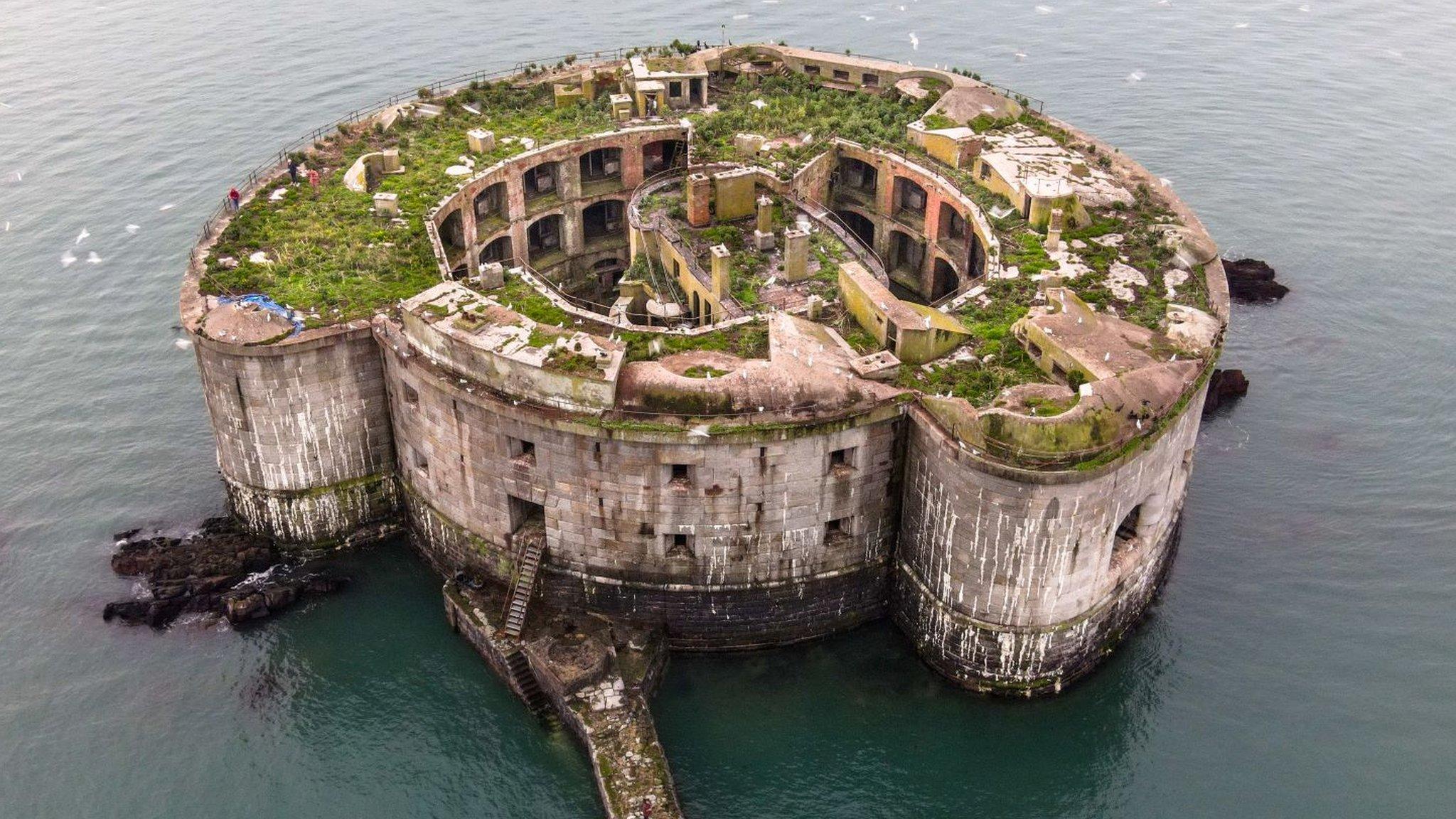Pembrokeshire: Photographer captures beauty of national park
- Published

Newport, pictured here, is a small town and ancient port on Pembrokeshire's north coast
With its otters, puffins, castles, miles of golden sands and dark starry skies there can be few counties more photogenic than Pembrokeshire.
Photographer Drew Buckley has spent his career capturing the varied landscapes and wildlife along Britain's only coastal national park and can't imagine living anywhere else.
"It's one of those places that I think is deeply set in a lot of people's hearts," said Drew, who lives in Pembroke.
"There's just so much to see around here... lots and lots of variety."

Drew's photograph of a seal at Marloes peninsula
During the Covid lockdown when the area was closed to visitors, Drew realised many people who usually holiday in Pembrokeshire were missing it - so he decided to do something about it.
He gave his followers on Twitter, now X, "their daily fill of Pembrokeshire" by posting a photo every day.
His photos took in all parts of the 186-mile stretch that makes up Pembrokeshire Coast National Park, ranging from the bustling seaside resort of Tenby to lesser-known bays and coves.
Soon people started suggesting he should turn it into a book - the result is Pembrokeshire: Discovering the Coast Path.

More than 38,000 Atlantic puffins visit Skomer to breed each year
Pembrokeshire's wildlife
For years, Drew has been capturing puffin breeding season on Skomer, an island off the coast of Pembrokeshire.
Each March more than 38,000 Atlantic puffins begin to arrive on the 720-acre island to breed and leave towards the end of July.

Common dolphins off the west coast near Grassholm Island
He also loves capturing the country's seals.
"There are coves up on the north coast and this time of year there'll be seal pups there," he said.
"Along the coast we tend to get quite a lot of kestrels and peregrines hunting a lot of the seabirds and the small birds.
"Lately it's been quite good at Bosherston with the otters. Last winter they were really, really good to photograph - there was a little family down there with three cubs and they were pretty much like clockwork so you could see them every day."

Church Door Cove is small amphitheatre-shaped beach with a colossal door shaped archway that has been cut into the cliffs by the forces of the ocean
Viewing the Milky Way
The national park boasts eight nationally recognised Dark Sky Discovery Sites and several of Drew's night time images capture the milky way.
"Night sky shots are all about the conditions and how clear it is," he said.
"On the south coast all you're looking over is the sea towards Cornwall so there's no land there, there are no towns or or cities that are going to destroy the the seeing with light pollution."
Some shots still take multiple attempts and the images in his book have been built up over a 10-year period.

St Davids Cathedral dates back to the 12th Century
Castles and a cathedral
The park is home to 286 scheduled ancient monuments, ranging from castles to burial chambers, hillforts and mills.
"Pembroke Castle is one of the highlights on the route," said Drew.

Broad Haven South is a large expanse of sandy beach which stretches along a craggy coastline
"It's such a fantastic big building... some days you just stop and look at it and you think 'well, that's pretty special'.
"We're blessed to have so many castles in Pembrokeshire."

Solva is a harbour village in the heart of Pembrokeshire
Pembrokeshire is also home to Britain's smallest city - St Davids.
"The cathedral is unbelievable with the stained glass windows," said Drew.
So where are his favourite places to photograph?

Ceibwr Bay is a tiny inlet of rocks and sand surrounded by tall cliffs
"Tenby is a bit manic this time of year but you can be sometimes the only person on the beach for sunrise or near to the twilight," he said.
"There's Whitesands on a windswept day or if you get the right conditions at Freshwater West it is just a magic place."

Druidston is a secluded long, sandy beach
Despite the thousands of hours he must have spent photographing the coastline, it is clear he is still inspired by what he sees.
"It's very privileged job," said Drew.
"Living here, growing up here, I say the waves are in your soul."

Tenby, seen here at twilight, is a bustling seaside town and a popular spot for visiting families
What is Pembrokeshire Coast National Park?
Pembrokeshire Coast National Park is one of Wales' three national parks, the others being Eryri (also known as Snowdonia) and Bannau Brycheiniog (also known as the Brecon Beacons).
The national park covers almost all the Pembrokeshire coast, every offshore island, the Daugleddau estuary and large areas of the Preseli Hills and the Gwaun Valley.

The rugged headland of Abereiddy
Nowhere in the national park is more than 10 miles from the sea.
It is ecologically one of the richest and most diverse parts of Wales and is recognised as of international importance for a wide range of high quality habitats and rare species.
Pembrokeshire Coast Path was officially opened on 16 May 1970.

Freshwater West is a popular spot for surfers
Drew's top spots for all-year round sunsets:
Freshwater West
Marloes Sands Beach
Newgale
Whitesands Beach

Landscape and wildlife photographer Drew Buckley has made a career photographing his local area
Drew's top places for sunrise watching:
Freshwater East
Barafundle Bay
Broad Haven South
Amroth
Tenby

A church-shaped rock off Broad Haven beach is lit by the moon
Drew's favourite spots for stargazing:
Castlemartin
Lydstep
St Ann's Head
Marloes
Martins Haven
- Published23 July 2022

- Published17 July 2022

- Published29 July 2023
